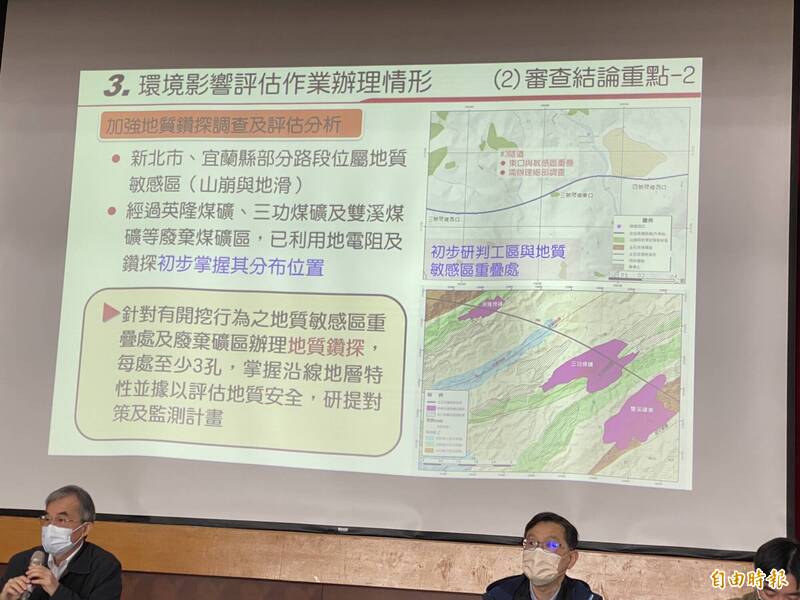The high-speed rail extension to Yilan project briefing session, the first environmental impact briefing session was held today in the auditorium of the Xizhi District Office in New Taipei City. People were concerned about whether the project and high-speed rail operation would cause noise, and some people worried about the impact on the ecological environment.
Officials from the Railway Bureau and Shixi Engineering Consulting Company said that tunnel entrances and viaducts are more likely to generate noise, which will be overcome by engineering means.
(Photo by reporter Yu Zhaofu)
[Reporter Yu Zhaofu/New Taipei Report] The high-speed rail extension to Yilan project briefing session, the first environmental impact briefing session was held today in the auditorium of the Xizhi District Office in New Taipei City. People are concerned about whether the project and high-speed rail operation will cause noise, and some people worry about the impact on the ecological environment .
The Railway Bureau and Shixi Engineering Consulting Company said that tunnel entrances and viaducts are more likely to generate noise, which will be overcome by engineering means. The Railway Bureau team said that the second phase of the environmental impact assessment will conduct a year-round survey of animals and plants in sensitive areas. The planning also tries to avoid important habitats for animals.
According to the provisions of the EIA Law, the Bureau of Railways of the Ministry of Communications held the "Explanation Sessions on the Environmental Impact of the High-Speed Rail Extension Yilan Project" in New Taipei City, Taipei City, and Yilan County successively, hoping to listen to local voices and serve as a reference for subsequent EIA and planning.
Please read on...
According to the review conclusion of Phase 1 "Environmental Impact Statement of High-speed Rail Extension Yilan Project" announced by the Environmental Protection Agency, there are 13 rare and precious wild animals such as civet cats, pangolins, red-bellied tits, and orioles along the route of the high-speed rail project and its surrounding areas.
The Environmental Protection Agency believes that the high-speed rail extension project in Yilan has significant adverse effects on environmental resources and the habitat and survival of protected or rare animals and plants, and the second stage of environmental impact assessment should continue.
Regarding how to preserve wild animals and plants, the Railway Bureau team stated that they have continued to pay attention to the ecology during the construction process. Taking the Yilan high-speed rail line as an example, they have tried to avoid the important habitats of animals when selecting the line. The second-level EIA conducts a one-year, four-season survey on sensitive areas.
The Railway Bureau team said that the most important area affected is the tunnel entrance, and the use area will be reduced as much as possible. As for the bridge section, the impact on civet cats is not significant, and it will continue to monitor in the future. For medium and large mammals with high concealment, automatic cameras will be used. Shooting, data collection and analysis on a regular basis, understanding of animal habitat conditions, developing mitigation measures and submitting them to the Environmental Protection Agency for review, will be implemented in accordance with the review results and mitigation measures to reduce the ecological impact along the line.
In addition, some staff from the Civil Service Office raised issues such as noise and coal mine sites left over from the high-speed railway line. The railway bureau team said that the main noise impact is at the tunnel entrance and viaduct. Iron plates will be installed at the expansion joints of the viaduct to prevent leaks. Noise, and sound insulation walls will be set up on both sides along the line, and additional space will be reserved for additional sound insulation walls.
Regarding the site of coal mine pits, the Railway Bureau team said that they have carried out detection during the planning stage and found that the high-speed rail is relatively close to Yinglong Coal Mine, Sangong Coal Mine and Shuangxi Coal Mine, and will try to avoid coal pits in route design. If it is avoided, it will try to avoid it by climbing up a slope.
According to the plan for the extension of the high-speed rail to Yilan proposed by the Railway Bureau, the Nangang Station will be extended to the east, and the high-speed rail station will be set up after reaching the Yilan area. The team of the Railway Bureau said that they hope to complete the environmental impact assessment and detailed design in 2024 and send it to the Executive Yuan. The high-speed rail will extend to Yilan The construction period is about 11 years.
The high-speed rail extension to Yilan project briefing session, the first environmental impact briefing session was held today in the auditorium of the Xizhi District Office in New Taipei City. New Taipei City Councilor Bai Peiru criticized today. The people of Xizhi have recently reported that the commuter trains of the Taiwan Railway cannot be crowded. I hope the central government will pay attention.
(Photo by reporter Yu Zhaofu)
The high-speed rail extension to Yilan project briefing session, the first environmental impact briefing session was held today in the auditorium of the Xizhi District Office in New Taipei City. People are concerned about whether the project and high-speed rail operation will cause noise. The high-speed rail bureau team said that tunnel entrances and viaducts are more likely to generate noise. Will use engineering means to overcome as much as possible.
(Photo by reporter Yu Zhaofu)
